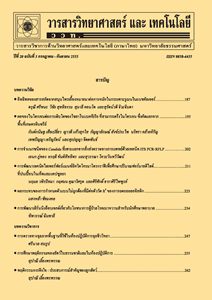การขยายพันธุ์หัวข้าวเย็น (Smilax glabra Roxb.) ด้วยการเพาะเลี้ยงเนื้อเยื่อ
Main Article Content
Abstract
บทคัดย่อ
หัวข้าวเย็น (Smilax glabra Roxb.) เป็นพืชสมุนไพรชนิดหนึ่งที่นิยมนำมาใช้ร่วมกับหัวข้าวเย็นอีก 4 ชนิด เพื่อรักษาโรคมะเร็ง เอดส์ เลือดเป็นพิษ และน้ำเหลืองเสีย จากความต้องการใช้ที่มีมากขึ้นจึงศึกษาวิธีการขยายพันธุ์ต้นหัวข้าวเย็น (S. glabra) ด้วยการเพาะเลี้ยงเนื้อเยื่อ งานวิจัยครั้งนี้จึงมีวัตถุประสงค์เพื่อหาสูตรอาหารที่เหมาะสมต่อการเพิ่มจำนวนยอดและชักนำให้เกิดรากของต้นหัวข้าวเย็น (S. glabra) ในสภาพปลอดเชื้อ วางแผนการทดลองแบบ completely randomized design ในการเพิ่มจำนวนยอด ทำการเพาะเลี้ยงข้อของยอดที่พัฒนาในสภาพปลอดเชื้อแล้วบนอาหารสูตร MS ที่เติม BA ความเข้มข้น 0.5 และ 1 มิลลิกรัมต่อลิตร ร่วมกับ IAA (indole-3-acetic acid), IBA (indole-3-butyric acid) และ NAA (a-naphthalene acetic acid) ความเข้มข้น 0, 0.1, 0.5 และ 1.0 มิลลิกรัมต่อลิตร เปรียบเทียบกับสูตรอาหารที่ไม่เติมสารควบคุมการเจริญเติบโต พบว่าอาหารเพาะเลี้ยงทุกสูตรที่ใช้ในการทดลองนี้สามารถชักนำให้เกิดยอดใหม่ได้ โดยอาหารสูตร MS ที่เติม BA ความเข้มข้น 1 มิลลิกรัมต่อลิตร ร่วมกับ IAA หรือ IBA ความเข้มข้น 0.1 มิลลิกรัมต่อลิตร สามารถเพิ่มจำนวนยอดได้ 4.6 และ 4.9 ยอด และมีจำนวนข้อต่อยอด 4.4 และ 4.5 ข้อ/ยอด ตามลำดับ ส่วนการชักนำให้เกิดรากนั้น ทำการเพาะเลี้ยงยอดบนอาหารสูตร ½ MS (half strength) และ MS ที่เติม NAA และ IBA ความเข้มข้น 0, 0.5, 1.0 และ 2.0 มิลลิกรัมต่อลิตร พบว่าอาหารสูตร ½ MS และ MS ที่เติม NAA และ IBA ทุกความเข้มข้นสามารถชักนำให้ยอดหัวข้าวเย็น (S. glabra) เกิดรากได้ ในขณะที่สูตรอาหาร ½ MS และ MS ที่ไม่เติมสารควบคุมการเจริญเติบโตไม่สามารถชักนำให้เกิดราก โดยอาหารเพาะเลี้ยงที่เหมาะสมต่อการชักนำให้เกิดรากของยอดหัวข้าวเย็น (S. glabra) คือ อาหารสูตร ½ MS ที่เติม NAA หรือ IBA ความเข้มข้น 0.5-1.0 มิลลิกรัมต่อลิตร เมื่อนำต้นที่มีรากออกปลูกในโรงเรือนพรางแสง 70 % พบว่ามีการรอดชีวิต 77.5 % หลังออกปลูกนาน 2 สัปดาห์
คำสำคัญ : หัวข้าวเย็น; การเพิ่มจำนวนยอด; การชักนำให้เกิดราก; การเพาะเลี้ยงเนื้อเยื่อ
Abstract
Hao-Khao-Yen (Smilax glabra Roxb.) is one of the medicinal plants which is commonly used with other four species of Hao-Khao-Yen to treat cancers, AIDS, septicemia and lymphatic diseases. The demand for medicinal purposes have been increased therefore propagation using plant tissue culture technique is required. The objective of this study was to investigate suitable media for in vitro shoot multiplication and root induction of Hao-Khao-Yen (S. glabra). The experiments were arranged in completely randomized design. For shoot multiplication, single-nodes from in vitro shoots were cultured on MS medium containing 0.5 and 1.0 mg/l BA in combination with 0, 0.1, 0.5 and 1.0 mg/l IAA, IBA or NAA comparing to MS medium without plant growth regulator (PGR) as control. The results showed that multiple shoots were induced on all tested media in the experiment. Number of shoots (4.6 and 4.9) and nodes/shoot (4.4 and 4.5) were high on MS medium containing 1.0 mg/l BA in combination with 0.1 mg/l IAA or IBA, respectively. Then, shoots were cultured on ½ MS (half strength) or MS medium supplemented with 0, 0.5, 1.0 and 2.0 mg/l NAA or IBA for root induction. Root formation occurred on ½ MS and MS media supplemented with NAA or IBA at all concentrations while ½ MS and MS media without PGR could not induce root. The ½ MS medium supplemented with 0.5-1.0 mg/l NAA or IBA were the suitable media for root induction of Hao-Khao-Yen (S. glabra). Rooted shoots were acclimatized and grown under 70 % shading greenhouse. Survival percentage of 77.5 was recorded after transplanting for 2 weeks.
Keywords: Smilax glabra Roxb.; shoot multiplication; root induction; plant tissue culture


